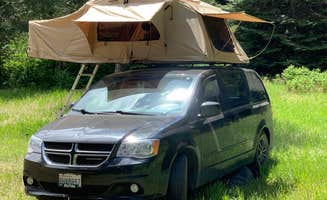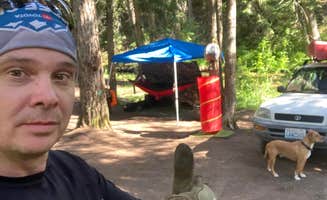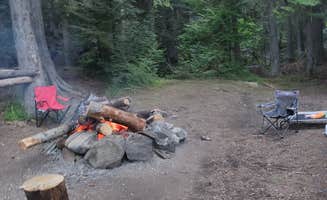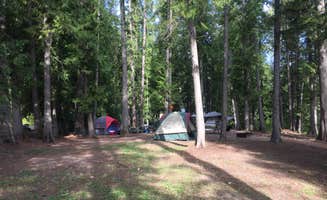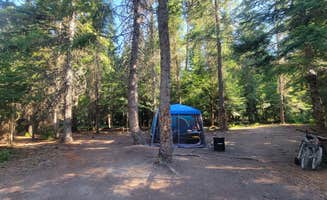Dispersed camping near Inchelium, Washington primarily occurs on land within the Colville National Forest and surrounding wildlife refuges. Situated at elevations ranging from 1,300 to 2,500 feet, the area experiences hot, dry summers and cold winters with significant snowfall. Primitive sites typically feature minimal development with fire rings being the most common amenity at established locations, though many require visitors to create their own temporary camping areas.
What to do
Fishing opportunities: North Fork Chewelah Creek offers several small fishing spots, though they're better for cooling off than serious angling. One visitor noted, "The godson loved it - he even played in the freezing cold water. I enjoyed the peace and quiet!" at North Fork Chewelah Creek.
Wildlife viewing: The Little Pend Orielle Wildlife Refuge provides excellent bird watching opportunities. A camper at Little Pend Orielle Campground mentioned, "Hearing the birds was really cool," while exploring the dispersed areas around the refuge.
Water activities: Swimming and wading are popular at multiple sites during summer months. A visitor at Cooks Lake observed, "The water was warm and we swam all day. Bats at night, and the stars!! Tadpoles and turtles and little water snakes" making it suitable for nature enthusiasts.
What campers like
Privacy between sites: Many dispersed camping locations offer good separation between camping areas. A camper at Cee Cee Ah Creek reported, "Nearby campsites are far enough away that you have plenty of privacy. There is a creek that runs through this area, which is great for cooling off on hot days."
Natural waterfront access: Campers frequently mention the direct creek and lake access as key attractions. One reviewer stated, "We decided to stay there because it felt pretty secluded, and there was one spot that was level enough for a tent…there was 12 inches of beach between the tent and the water!" when describing their experience at Cooks Lake.
Abundant wildlife: Animal sightings enhance the primitive camping experience. A camper noted, "Birds everywhere, woodpeckers in the birch trees and killdeer darting down to the water. Chipmunks and rabbits." The diverse ecosystem supports various wildlife viewing opportunities throughout the seasons.
What you should know
Fire pit availability: Most established dispersed sites contain previously used fire rings. At North Fork Chewelah Creek, a camper observed, "There are established stone fire pits or you can gather up some rocks and make your own. Plenty of deadfall and fire wood all over the place."
Toilet facilities: Many primitive sites lack proper facilities. A visitor at Campbell Park at Box Canyon Dam warned, "There is a vault toilet that was disgusting, beware." Always bring personal sanitation supplies.
Seasonal access changes: Road conditions vary dramatically by season. One camper noted, "The road to get there was approx six miles of gravel winding single lane road. But so worth the drive for the beautiful shaded sites and the open Lakeview sites." Four-wheel drive becomes essential during spring thaw and fall rains.
Tips for camping with families
Swimming options: Several sites offer small swimming areas for children. A visitor at At the Lac Dispersed mentioned, "Nice place on public land. Swimming possible. We stayed for the night," making it a good option for families seeking water recreation.
Safety precautions: Bear activity requires proper food storage. One camper advised, "It is bear county so be sure to bring bear proof containers although it was so hot when we went that the wildlife was hiding out." Bear canisters or proper food hanging systems are essential.
Navigation challenges: Families should prepare for limited signage. A camper at Little Pend Orielle Campground cautioned, "Bring a GPS and have good map reading skills to avoid getting lost; it's easy to lose yourself." Download offline maps before arrival.
Tips from RVers
Site access limitations: Many dispersed sites have narrow access roads. One RVer noted, "Roads into the area are narrow gravel roads, so 'large' rigs and/or trailers may find it a challenge," when describing Little Pend Orielle Campground.
Leveling requirements: Finding level parking can be challenging. An RVer at Cooks Lake shared, "At least 2 of them are good for my trailer although I wouldn't try if you're not experienced with towing." Most sites require additional blocking or leveling equipment.
Mud conditions: Weather can quickly change ground conditions. One RVer warned, "Decided to drive down to the water (that was hardly there) and found myself barely on the edge of lake bottom mud. Didn't get out till the next morning." Check weather forecasts and avoid low-lying areas after rain.


